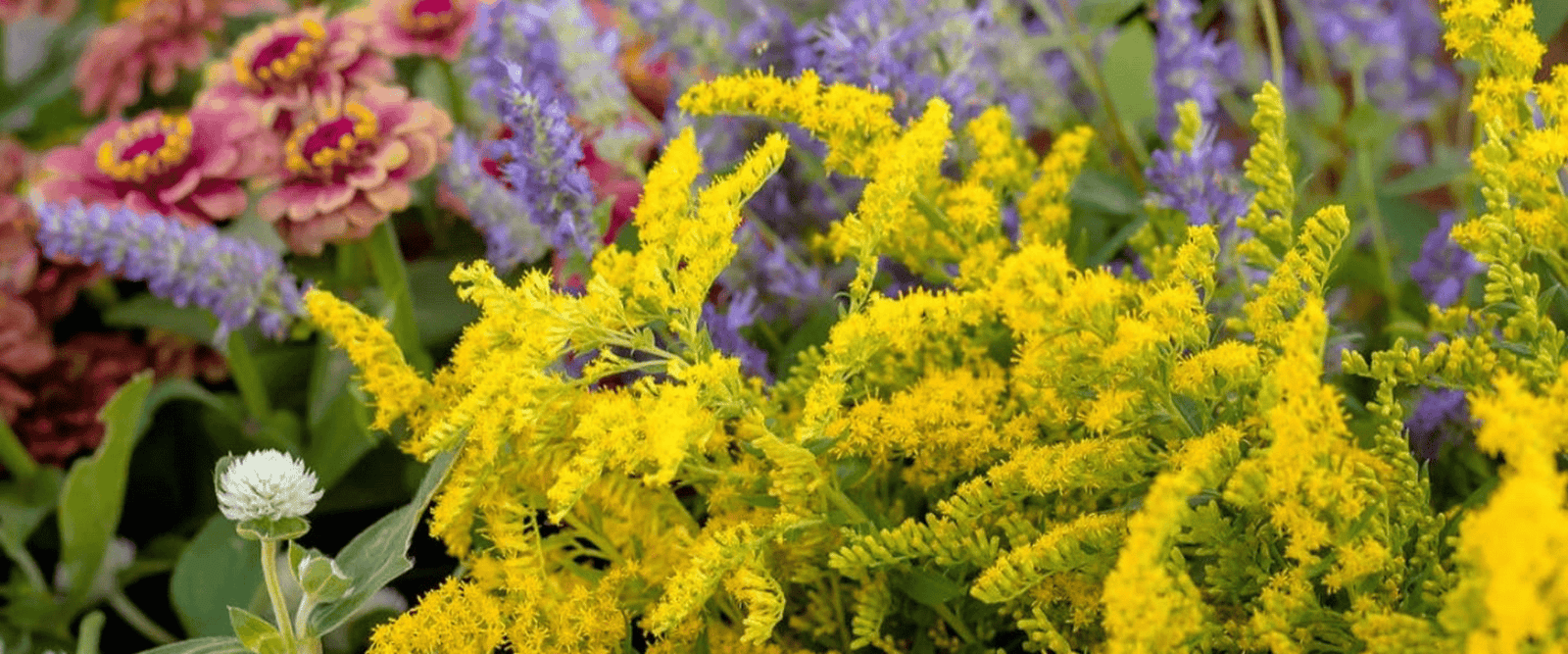
Today, we are going to talk about types of cut flowers. Think of it as a little vocab lesson. It’s an important one to know so that when you’re reading about types of cut flowers to grow, you know what is being referred to.
Tender Annuals: These are basically annuals that you plant in the spring after your last frost. So, in my area, that’s May 15th. You start them from seed; it takes a couple of months for them to flower, then when the frost comes they die. Good examples of those are zinnias, sunflowers, cosmos, and basil. A lot of these you can start directly from seed in the ground, but a lot of them you could start in trays to give them a little bit of a head start. We talked about days to maturity for a lot of these flowers in earlier posts. In a place like Minnesota (Zone 4), with a short growing season (only 120 days of growing), they’re gonna need a lot longer actually to get blooms and get something out of them. Sometimes, you want to start them ahead of time. So those are what tender annuals are.

Hardy Annuals: They’re also annuals because you plant them, and then they usually die at the end of the year. They don’t come back year after year like perennials, but they can handle frost. I started really experimenting and adding these in year three. In year two, I added a few of them, but for year three, I read a book by Lisa Mason Ziegler called Cool Flowers. You can find it here.
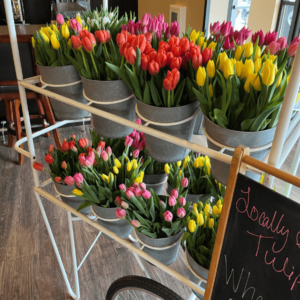
The book talks about flowers that can handle frost. In her book, she’s growing out on the East Coast. It’s just totally a totally different Zone than here, where we literally have a foot of snow on the ground right now, and we’re supposed to get pounded with 15 inches of snow tomorrow, and it’s almost March here in Minnesota. So, her Cool Flowers ideas don’t quite work here when it’s literally subzero temperatures a lot of the time. Her thing is that you can plant them in the fall, and you cover them with frost cloth or overwinter them, and then in really early spring, you’ll have flowers. While it doesn’t work entirely the same where here, you can cover your plants with frost cloth so that the ground doesn’t fully freeze, and you can get things planted a lot earlier and then still get blooms a lot earlier. That’s what I’ve really been focusing on so that I have something between tulips and when the rest of my tender annuals are blooming the week after the 4th of July. I’ll plant them in early spring. I like to leave my black landscape fabric down so that the soil heats up sooner, and then I can till it, and I can work in the ground earlier. Typically, these flowers will flower earlier, and then they fade once the weather gets hot. Examples of these flowers are orlaya, false Queen Anne’s lace, stock, salvia, Bells of Ireland, and nigella. About half of those can be direct-seeded just straight into the ground, and then the other half I do start in trays. I bought a whole flat of Bells of Ireland to transplant into the ground as plugs, and some stock, too. But salvia is so easy to start from seeds – you do it six weeks before you want to plant them outside, so it’ll actually be mid-March when I start those. They’re hard to kill so I will do those. But anything that’s easy to kill, I just don’t mess around with and buy plugs because I don’t have time to baby seeds.
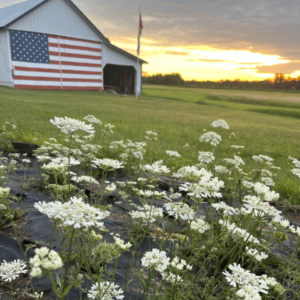
Bi-Annuals: The first year just leaves, and then in the second year, you get flowers. So, they’ll flower, die, turn to seed, and try to live again. Foxglove and Sweet William are two varieties that have been genetically modified (certain varieties of them) to flower in the first year. It’s not as big of blooms, but they will flower in the first year. Quite honestly, I don’t mess with them yet because I just don’t have the space for them. You need to dedicate a space that isn’t going to bloom this year, and then they’ll bloom next year. The perk of this, for Zone 4 at least, is that you usually get those blooms in June. As I said, I really struggle to have anything from the first week of June until the 4th of July. And my customers do want them because they’re so excited after tulips. As I said in an earlier post, it’ll be a couple of years before my peonies are really producing the way I want them to, so I’ll just see. You usually plant them mid-summer because you want them to be established and growing about 6 to 8 weeks before the last frost. Here, that’s mid-September, so I’d start them around mid-August. That would be nice because I’m probably not planting much else at that point. I usually quit planting most of my annuals (sunflowers, etc.) about mid-July. So, we’ll see … I think that’s something that I need to look into a little more, but I really just don’t have the space to dedicate to something that’s not going to produce a flower this year. And the year that they’re not producing flowers, they’re not even pretty; they’re just green, and I’m kind of no fuss. I don’t have room for high-maintenance stuff.

Bulbs, Corms, and Tubers: People think they’re all the same thing, but they’re really not. For example, tulip bulbs, dahlia tubers, ranunculus corms – basically, they’re kind of a big root system. Some of them you can leave in the ground year after year if you’re not cutting them, like tulips, and then they’ll come back year after year in Minnesota. With dahlias, if you live in a really warm climate where the soil doesn’t freeze (it’s fine if it freezes above the ground), the plant dies, but you can put some mulch on it, and as long as the tuber doesn’t freeze, it will come back year-after-year. Whereas in Minnesota, you have to dig those up in the fall, store them, divide them … it’s a whole big thing. It’s literally its own division (dahlias are) within the cut flower industry, and I don’t think we’re going to be able to do that in one post. We’re going to need multiple posts on dahlias. I’ll probably do that one in the fall, just because that’s when you’re digging them up and dividing them.
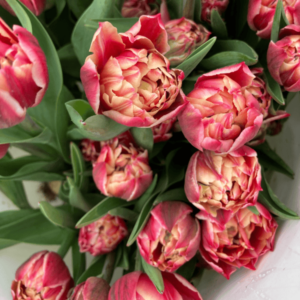
Depending on what they are, some of these “categories” you plant in the fall, and some you plant in the spring. They’re not really the same category, but people think they are – tulips you plant in the fall, dahlias you plant in the spring around here, etc. Tulips have to go through a freeze or a cold period. I feel like 35° is sufficient, but essentially a hard freeze, and then they store up energy and can produce another flower the next year.
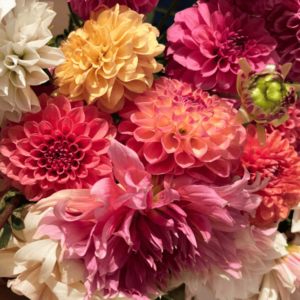
Perennials: come back year after year. Typically, the greenery will die back when it freezes, and then usually, they get bigger every year, with more flowers each year. They usually have a narrow window of bloom time, but they can be very, very useful for cut flowers – especially if you focus on ones that bloom earlier in the summer. Keep in mind that a lot of them don’t have a very good vase life, like irises, for example, they last a couple of days. If I sold a ton of bouquets of them, I don’t think my customers would love them if they died after two days. I love them, and I cut them and bring them inside because they’re pretty, but they only live a few days. I have rows of sedum, coneflower, and phlox, and I grow them in 65-foot rows, which is a really random length, but that’s what I already have in these long rows. Then this spring, I’m actually planting some rows of delphinium and yarrow. The delphinium will come back year after year, and they should produce flowers already this year, along with the yarrow, so I’m excited about that.
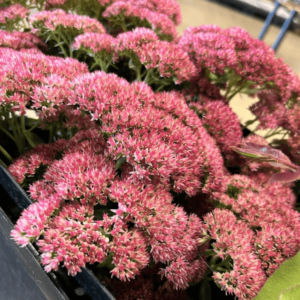
One thing when it comes to perennials, which you will see with things like lilies and hostas, is that people will have these huge plants. They do need to divide after a while. So, when you divide them up, you just dig up the whole plant and cut it in half or in thirds. The first year it sleeps, year two it creeps, year three it leaps, and then usually, year four it heaps, and you’ve got to divide it up and start the cycle all over again. It’s kinda like when you get a haircut – the day before your haircut, it’s looking great, and you regret that you’re going to get it cut. Like, “Why am I getting this?”
Vines: for cut flowers. I don’t really use a whole lot of these, but for plants like clematis (the climbing vines), the flowers themselves don’t live a long time, but if you let them die back naturally, then just use the vine and the pods in the vase. That can look kind of pretty in what I call floral art arrangements, which I don’t do. I don’t do floral art. I’m not an artist, I don’t make pretty arrangements. My customers are used to my style, they like my style, and they like my bouquets. I leave the floral art up to the experts. I think, eventually, I’ll start taking more floral arrangement classes, but that’s not what I market. And quite frankly, my customers don’t wanna pay for it, and that’s okay. I think there’s a market for it, but not with my audience. They don’t want to pay $80 for a big arrangement. They want to pay $30 for those same flowers. They’re not to be perfectly symmetrical, and they can move them around; they can cut them. I’m mindful of how I arrange them, but my style uses about 10 different kinds of flowers, 15 stems total, and it has more of a wildflower, whimsical look.

Shrubs: some of my favorites that I use around here are Russian sage and spirea. Actually, you can drive around town and probably see a ton of spirea bushes or plants around people’s landscaping. You can trim them back; they flower in the spring, usually around peony time. I really like to use the pink ones with white peonies in a vase – it ends up really pretty. The Russian sage is more of a shrub bush and adds a spike in height. They remind me a lot of salvia.
Flowering Trees: Around here, that’s like pussy willow and flowering crab trees. You have to pick them when they’re barely opening; otherwise, the petals are gonna fall off. It’s really only pretty for a few days, but you can put some of those branches into a big arrangement, not necessarily a bouquet, but a big arrangement. I will use some of them in the fall with certain colors of dahlias, and it ends up being really pretty. I take the branches with just the berries on them, and I put those in the vase. I make sure I take all of the leaves off the twigs, and I just use really small twigs, not necessarily branches. For the most part, I use mason jars for my flowers and that can end up being just really pretty and useful.
Another thing that people don’t really think about, but I use a ton of it because I have a lot of them growing in my grove of trees, is actually raspberries. There are two different kinds of raspberries – primocanes and floricanes. They make a second shoot, and then the berries are on that one the next year. We eat them in June when they have berries, and then I like to cut them for the greenery and just use them as leaves in the fall. They end up just really pretty, and they last a long time in the vase. But I just make sure that I’m cutting from the ones that produced berries this year, and you can tell because the branches are a lot woodier, and those need to be cut anyway. If you cut the other branches, they’re not going to produce berries the next year, so you have to be really careful. Don’t come at me if you kill your raspberry crops … you won’t actually kill them; they just won’t produce as many berries the next year. So, just gotta be careful about which ones you cut.
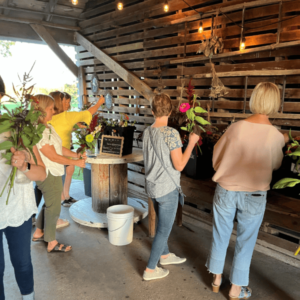
As you listen to the podcast or read the blog, and I talk about tender annuals, hardy annuals, perennials, corms, tubers, etc., you’ll know what all these things mean. Hopefully, I didn’t make it too boring, but it’s necessary. Not everything is super fun, but you just kind of have to go through the vocab so you know what things are.
Liz:
What questions do you have for me, Abbey?
Abbey:
I have only one. It may be a stupid question.
Liz:
There are no stupid questions.
Abbey:
So, you were talking about bi-annuals. So, do you only get one year of flowering from them? Or is it like an every-other-year thing?
Liz:
They die after two years.
Abbey:
Okay, so you plant them, and it’s green, next year comes back and flowers, and then you’ve got to dig it up and start all over.
Liz:
Mmhmm. Yep. There are some varieties that will produce the first year, but they’ll be small, and a few stems.
Abbey:
Okay, that seems like a lot of work for only one year of flowers.
Liz:
Exactly, put it this way, if I ever end up having rows bi-annuals, I have too many employees, too much time on my hands, etc. Brent and I were talking about it (Brent is Flower Farmer Fiancé), and I just don’t think that there’s a huge market for something like that within my business and within my customer base for something that takes that much effort. I mean, nobody’s coming here for the Sweet William. Plus, the foxglove is really pretty, but it’s poisonous. So, I try not to grow things that are gonna be poisonous to the cat. I just don’t have a market for growing it. I mean, I don’t think anyone would come here for that, and if they’re that much work, it’s not worth it
Abbey:
It feels like a limited-edition shoe drop people would wait out in line in LA for, but it’s not a Central MN thing.
Liz:
It’s knowing your audience. I mean, who knows, maybe people are like, “Ugh, I was going to buy from you, but you didn’t have any Sweet William in late June, so whatever…” But again, it just depends. I think there are options to have blooms in June, but I have other plans. Maybe if I unalive a ton of ranunculus or the peonies didn’t do great, I’d explore other options for season extension. Ashley, if she’s listening/reading, I’m using your term/stealing your term “unalive.”
Abbey:
That’s all I had for questions.
Liz:
Alright, sounds good.
Thanks for listening to/reading the Sunny Mary Meadow podcast/blog. I’m your host, Liz. If you like what you’re hearing/reading, please subscribe and rate us. You can also find us on Instagram, Pinterest, and Facebook.
You can subscribe to our email newsletter below. We love to hear any podcast-related feedback at our email podcast@sunnymarymeadow.com, and all other inquiries can be sent to liz@sunnymarymeadow.com.